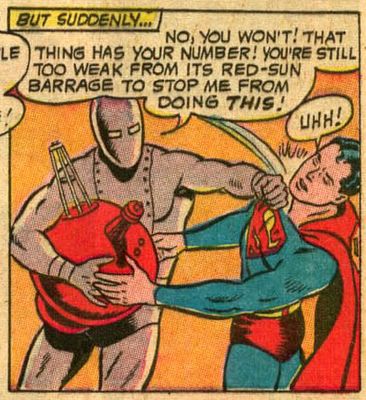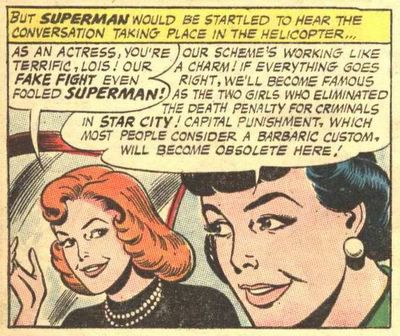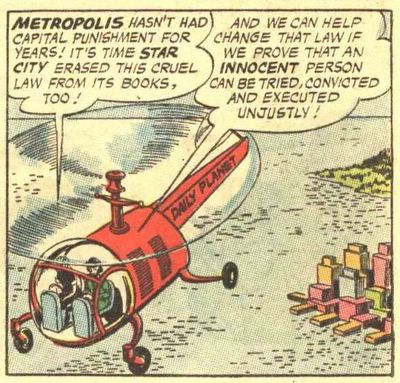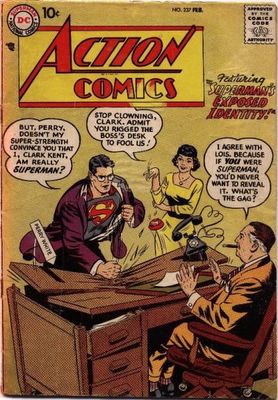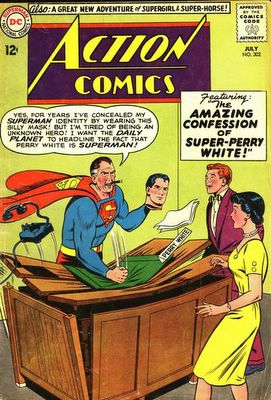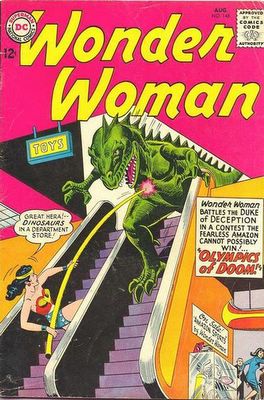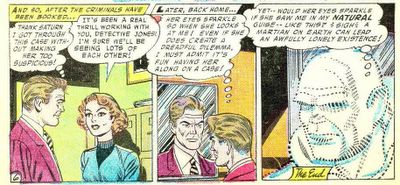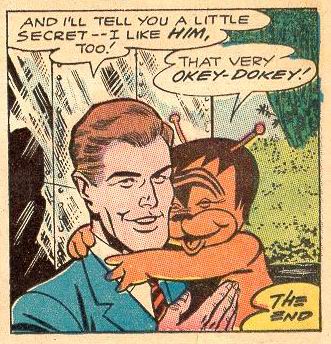Originally there was no Superboy. Clark Kent's childhood was not discussed in any great detail in Action Comics #1, with only one panel showing the infant's strength to the amazed doctors in the orphanage.
But in More Fun Comics #101, (Jan/Feb 1945), DC decided to start telling the back story of Superman as a boy. After a brief run, the series shifted over to Adventure Comics, where it settled in for over 15 years as the cover feature. A few years after that, Superboy was given his own magazine as well, which lasted even longer.
It turned out (impossibly) that Superboy had been world famous himself. Impossibly, because of course in the early Superman stories he was a man of mystery whom nobody had ever seen before. Now we were being told that schoolchildren around the world knew his name. But this was only the beginning of the tangled knot.
Over the years, DC had developed many familiar situations for Superman. For example, he would often be faced with the problem of appearing as Superman and Clark Kent at the same time. In the late 1950s, obviously inspired by science fiction of the time, he invented robots that could take either of his places. Naturally there was a tendency to backdate this into the Superboy stories, regardless of whether it made sense, given the era in which the Superboy stories were supposedly occuring. If Superman's in 1955, then Superboy is in the early 1940s, certainly no later than 1945.
Similarly, DC "grandchilded" into the Superboy stories some of his later friends and enemies. Lex Luthor was a buddy of Superboy as a teen and only turned bitter when an experiment gone awry resulted in him losing all his hair. Master Mxyzptlk popped up in Superboy #78 (Jan 1960). Both these stories of course contradicted the original appearances of those villains in Superman stories.
More serious problems developed as a result of time travel. Time travel is always an interesting plot device and you will note that most of the DC heroes of the Silver Age had one method or another of traveling through time. Batman could be hypnotized by Professor Nichols, the Flash had his cosmic treadmill, the Atom his time pool, Superman could fly in circles, and for the rest of the DC crew there were the ubiquitous glass bubbles.
In Adventure #247, DC introduced the Legion of Superheroes, a future group of do-gooders who invited Superboy to join them. So far so good. But later on in Action #252, they decided to create Supergirl, a young cousin of Superman who survived the explosion of Krypton. Naturally she had to join the Legion of Superheroes as well. Which meant that in the future, Superboy and Supergirl would team up. But why then had Superman acted surprised when his cousin arrived; wouldn't he have known since his teen years that Supergirl would come to this planet? The editors quickly explained that Saturn Girl placed a post-hypnotic suggestion in Superboy's mind that resulted in him forgetting about Supergirl when he was in the past.
A further error was made in Adventure #253, when Robin comes back in time to save Superboy from a booby-trapped clock. He tells Superboy of his future, including his teamups with Batman. Again, these stories are wildly contradicted by earlier tales.
More about →
But in More Fun Comics #101, (Jan/Feb 1945), DC decided to start telling the back story of Superman as a boy. After a brief run, the series shifted over to Adventure Comics, where it settled in for over 15 years as the cover feature. A few years after that, Superboy was given his own magazine as well, which lasted even longer.
It turned out (impossibly) that Superboy had been world famous himself. Impossibly, because of course in the early Superman stories he was a man of mystery whom nobody had ever seen before. Now we were being told that schoolchildren around the world knew his name. But this was only the beginning of the tangled knot.
Over the years, DC had developed many familiar situations for Superman. For example, he would often be faced with the problem of appearing as Superman and Clark Kent at the same time. In the late 1950s, obviously inspired by science fiction of the time, he invented robots that could take either of his places. Naturally there was a tendency to backdate this into the Superboy stories, regardless of whether it made sense, given the era in which the Superboy stories were supposedly occuring. If Superman's in 1955, then Superboy is in the early 1940s, certainly no later than 1945.
Similarly, DC "grandchilded" into the Superboy stories some of his later friends and enemies. Lex Luthor was a buddy of Superboy as a teen and only turned bitter when an experiment gone awry resulted in him losing all his hair. Master Mxyzptlk popped up in Superboy #78 (Jan 1960). Both these stories of course contradicted the original appearances of those villains in Superman stories.
More serious problems developed as a result of time travel. Time travel is always an interesting plot device and you will note that most of the DC heroes of the Silver Age had one method or another of traveling through time. Batman could be hypnotized by Professor Nichols, the Flash had his cosmic treadmill, the Atom his time pool, Superman could fly in circles, and for the rest of the DC crew there were the ubiquitous glass bubbles.
In Adventure #247, DC introduced the Legion of Superheroes, a future group of do-gooders who invited Superboy to join them. So far so good. But later on in Action #252, they decided to create Supergirl, a young cousin of Superman who survived the explosion of Krypton. Naturally she had to join the Legion of Superheroes as well. Which meant that in the future, Superboy and Supergirl would team up. But why then had Superman acted surprised when his cousin arrived; wouldn't he have known since his teen years that Supergirl would come to this planet? The editors quickly explained that Saturn Girl placed a post-hypnotic suggestion in Superboy's mind that resulted in him forgetting about Supergirl when he was in the past.
A further error was made in Adventure #253, when Robin comes back in time to save Superboy from a booby-trapped clock. He tells Superboy of his future, including his teamups with Batman. Again, these stories are wildly contradicted by earlier tales.
